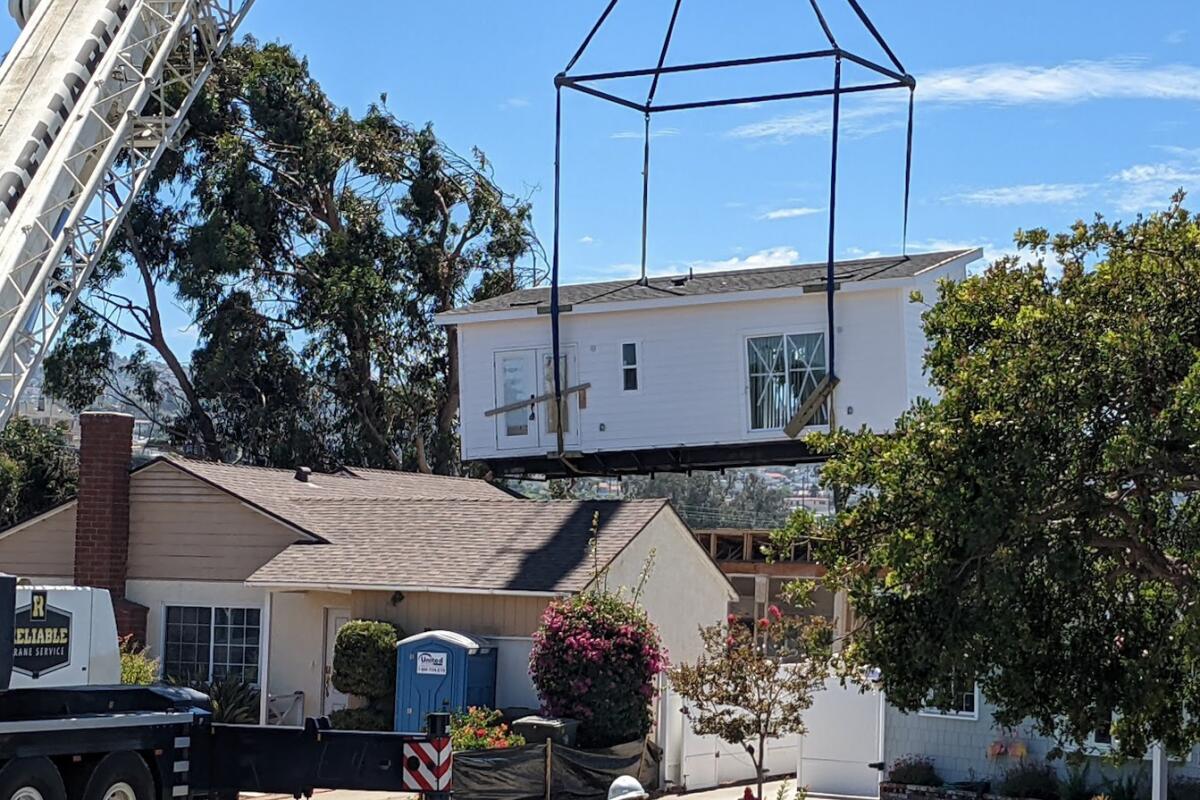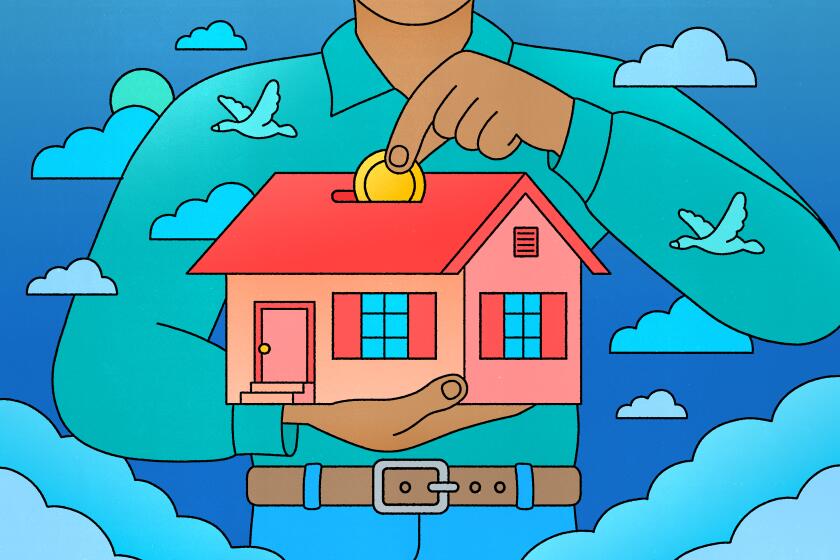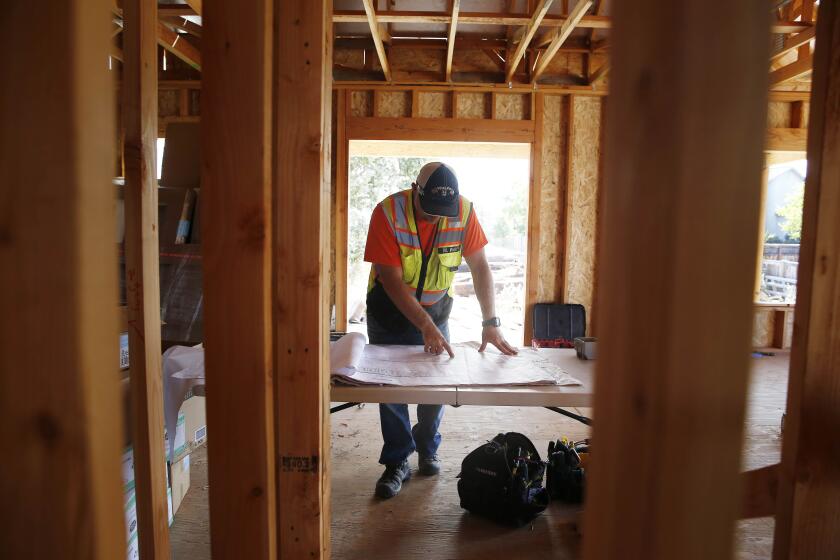Pilot program offers Long Beach homeowners up to $250,000 in low-interest loans to build ADUs

- Share via
Eager to boost the supply of affordable housing, city officials in Long Beach devised a program that could help a limited number of homeowners build an extra unit on their land.
But before they could launch it, they had to decide what to call it.
“We’ve been playing with a name for a while,” Mayor Rex Richardson said, noting that a news release touting the program had been delayed days because of christening purposes. “We’re building the bike as we ride it.”
Long Beach officials settled on the self-explanatory “Backyard Builders Program,” hoping a partial solution to a dearth of affordable housing lies in the unused spaces of city homeowners’ property. It’s a concept widely supported by advocates of low-income housing although some argue that the city’s version should have included more tenant protections.
Long Beach’s pilot program uses one-time funding that will provide as many as 10 homeowners low- to zero-interest loans of up to $250,000 to build Accessory Dwelling Units, or ADUs, on their lots. Those units would have to be rented out to lower-income individuals or families for a minimum of five years.
Interested applicants can apply at https://www.longbeach.gov/lbcd/hn/aduloan/.
“Long Beach has been a leader on ADU production,” Richardson said. “And we’ve done all the things we need to do ... to make it easy for people to develop ADUs in their backyard.”
Claremont McKenna College’s Rose Institute confirmed in an April report that Long Beach was among the most ADU-friendly cities in the state, having issued 1,431 ADU permits between 2018 and 2022. While that total trails larger cities like San Diego (2,867), Long Beach produced 317 permits per 100,000 residents.
An ADU, as defined by the city’s Community Development Department for this pilot program, must come with independent facilities that include a living room, sleeping area, kitchen and bathroom.
In addition to agreeing to the temporary rent limit, property owners must live on site and have less than four units already on their land.
The units may be rented to anyone earning 80% or less of the Los Angeles County median income, which translates into $77,700 for an individual, $88,800 for a two-person family, $99,900 for three people and $110,950 for four, according to the Los Angeles County Department of Regional Planning.
But the program gives homeowners an extra financial incentive to rent these ADUs to recipients of Long Beach’s housing choice voucher program, which provides a portion of the rent for those who fall into extremely low income, very low income or low income categories.
You’ll probably need some kind of loan to help pay for an ADU. Your options will depend on your income, your home equity and your current mortgage.
Building an ADU has grown more expensive in recent years, with labor and material costs jumping 11% and 9%, respectively in 2021 and 2022, while construction labor costs rose 34% between 2018 and 2023.
The loan covers up to $250,000 in planning, permitting and construction costs, though Kelli Pezzelle, a Backyard Builders community program specialist, doesn’t anticipate the loans needing to be that high.
The interest on the loan will remain at 0% as long as the owner rents the ADU to a low-income recipient. A stipulation for loan qualification is that the owner must rent the home to a voucher recipient for a minimum of five years or a nonvoucher, lower-income tenant for seven years.
The loan’s interest rate will jump to 3% if rented to someone who doesn’t meet the income limits after the five- or seven-year period. An owner would incur a $2,500 monthly penalty if the ADU is rented to a nonqualified tenant ahead of time.
The possible removal of low-income tenants concerns Long Beach Residents Empowered, or LiBRE, an advocacy group that pushes for the creation and preservation of affordable housing and renter protections.
“We’re happy that the city is investing in affordable housing and trying to reduce the housing shortage,” said LiBRE’s Project Director Andre Donado, via a phone call. “Every single renter, however, is at risk of eviction after five years.”
Donado also hoped the city would consider offering relocation assistance of $4,500 to low-income renters displaced through no fault of their own in all cases.
The city offers $4,500 or two months rent if a landlord demolishes or substantially remodels a building, but only one month’s rent in other cases.
“I think there are several positives with the program, and we’d like to see it made permanent, with some adjustments,” Donado said.
A popular state program to help pay for the cost of building an ADU is back, but with lower-income limits for applicants and less money to award.
The pilot’s loans are significantly larger than the up to $40,000 in aid provided by California Housing Finance Agency’s ADU Grant Program, which doled out $125 million to help homeowners cover permitting and planning costs before running out of funds.
The city believes that house-rich, cash-poor homeowners, particularly seniors, could take advantage of the loan to build an ADU and create passive income. The program estimates that the ADUs built with its loans would generate more than $1,000 monthly for owners who rent to voucher holders.
“You may be a grandma or someone who’s got way too much backyard, and you want to be a part of the solution, but it may be hard for you to navigate or identify financing,” Richardson said.
To that end, the city is expected to appoint a project manager to help loan recipients choose an architect, builders, planners, contractors and others needed throughout the planning and construction process. That manager will work as an intermediary between the property owner and the general contractor.
One caveat for interested property owners is that a qualified renter cannot be a relative or a caregiver for their household.
As for the loan, payments will be deferred during the building process up to two years.
Richardson said since the program is based on loans that will be repaid over time, it will be self-sustaining. If it’s deemed a success — meaning that ADUs are built and rented to lower-income tenants — he said the city would consider looking for more revenue streams to expand the project.
The city is hosting a series of Zoom webinars to gauge interest in the program and answer questions.
More to Read
Sign up for Essential California
The most important California stories and recommendations in your inbox every morning.
You may occasionally receive promotional content from the Los Angeles Times.












